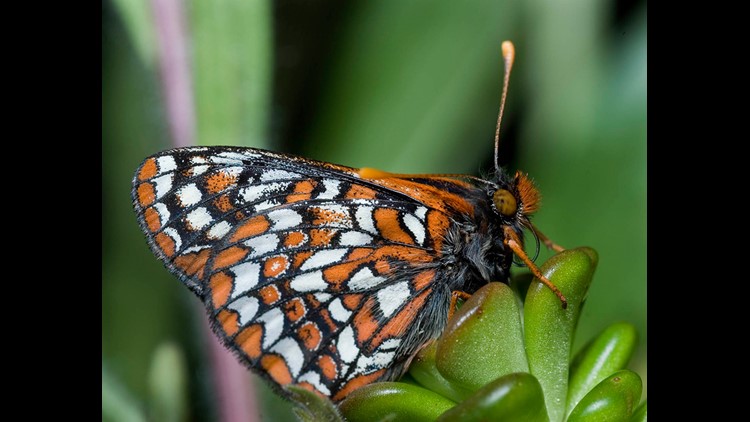Nearly 750 endangered butterflies are headed home from the Coffee Creek Correctional Facility.
For most of the past year inmates at Coffee Creek have raised and cared for Taylor's checkerspot butterfly larvae. This is a program between the Oregon Zoo, U.S. Fish and Wildlife Service and the Institute for Applied Ecology.
Last week 476 of the caterpillars were transferred to be released on prairies near Corvallis, Oregon. Another 246 are scheduled for release this week. This is the second ever release of Taylor's checkerstpots in Oregon. Last year was the first with 562 Coffee Creek reared caterpillars. There are only two known population pockets of this rare Northwest butterfly currently, according to the Oregon Zoo.
"Having a captive rearing and release program in Oregon is vital for the recovery of Taylor’s checkerspots," said Oregon Zoo butterfly conservationist Ronda Naseth, who advises the program at Coffee Creek. "Bringing butterfly conservation work into a medium-security housing unit continues to be a rewarding process.”
Rearing the rare butterflies comes with many challenges. One of the most difficult tasks is feeding the ever-munching larvae, which require vast quantities of specific plants. The Institute for Applied Ecology assists the lab in supplying, propagating and harvesting plantago plants for this purpose. The level of care is crucial: The species is listed under the U.S. Endangered Species Act and, according to Xerces Society for Invertebrate Conservation, is in imminent danger of extinction.
In addition to the inmates who rear the Taylor’s checkerspots, another team of inmates is dedicated to the care and harvest of the 2,200 plantago plants that feed the larvae. Two of these plantago crew members have been cross-training in the butterfly lab since February, sharing the knowledge they are gaining about the larvae’s nutritional needs with their fellow crew members.
The Coffee Creek-reared caterpillars will complete their development in the wild, first turning into chrysalides and then — over a span of warm, sunny days this spring — emerging as adult butterflies and unfurling for the first time their distinctive, colorful wings.
Though once abundant across the inland prairies of the Pacific Northwest, the Taylor's checkerspot has now lost 99 percent of its grassland habitat to successional plant growth, agriculture and urban development. And while the butterflies themselves are small, the restoration of their high-quality native prairie habitat also benefits a multitude of other species associated with this ecosystem.
The Oregon Zoo has provided more than 28,000 checkerspots for release since joining the recovery effort in 2004 — including a record-setting 5,398 larvae transferred to the Washington Department of Fish and Wildlife last month for release in the south Puget Sound area, where some of the region's best prairie habitat remains.



